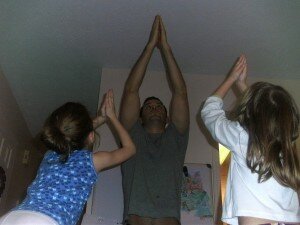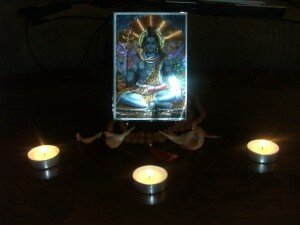Posts Tagged vegetarian
Month One: Day 27/Hinduism in Review
When I was a kid I hated to try new things. I was a creature of habit. My parents had to make me try new things. “You’ll love soccer, if you tried it out.”
No thanks. I’ll stick to being anti-social and building forts in the woods.
But Mom and Dad had a mission: to expose me to everything they could so that I might develop into a well-rounded young man. Well, I don’t know if I turned cultivated but I did end up liking soccer.
So what’s my point? Project Conversion is an effort to take the lessons my parents taught me about trying new things and looking through the perspectives of others and apply that to the religious violence and bickering that has our world up in flames today. But instead of preaching about it, I decided to show the world how it’s done by putting my money where my mouth is and living it.
One man. Eleven faiths. One year to practice them all. That’s the mission. To live life in the shoes of another. And it started January 1st, 2011 with Hinduism. As promised, here is my review of the month I’ve lived.
What I’ve Learned/What Misconceptions Were Overcome?
“Truth is one, though the wise call it by many names” –the Rig Veda
When I began planning for Project Conversion, my future Jain Mentor told me that “Hinduism is the United States of philosophy.” I didn’t get it at the time but now I understand. Hinduism, like the US of A, is an amalgam of philosophies and theologies joined by a common religious “genetic” ancestor or goal. That’s what is meant by the above quote from the Rig Veda and arguably the whole meaning of Sanatana Dharma.
As I prepared for my month with Hinduism I felt overwhelmed. “So many gods,” I thought. “So many rituals, traditions, and history. Where do I begin?!” Because I grew up as Christian and was accustomed to only one form of God (Jesus) and one scripture (the Bible), the notion that within one religion I had a choice between different deities and holy scriptures was mind-blowing. Truth, it turned out, wasn’t relative, but a singular goal reached by many, many roads. But time was running out and I had to pick a road fast. I selected Shiva as my deity and thus narrowed down how my month would play out.
Shiva is the third aspect of the Supreme Reality (God), Brahman. As Shiva, we understand the creative and destructive cycles of nature. Shiva also represents the detached ascetic, persistent in meditation on the pervasive reality (the divine Self within and outside of us all), and covered in the ashes of burned sin (ignorance). He is represented by the lingam.
The lingam represents the formless, abstract reality of the divine. In Sanatana Dharma, there is freedom to use representations of the divine (murti) in order to meditate and focus on God, however the aspirant is encourage to develop his devotion to the point where such tools and methods are obsolete, as he reaches moksha, the realized state in which all is Brahman–including ourselves.
There are literally thousands of representations of the divine, each for one or more of its aspects. This is why figures like Jesus, the Buddha, and Krishna are all acceptable as projections of the divine within Hinduism. Each are a way to Truth. When I began this month, I clearly thought that Hinduism was a polytheistic faith due to these various representations. Now I know that, depending on which school of thought a Hindu belongs to, they are either monotheists (God exists as a part of and/or outside of creation and selects manifestations) or monist (the divine is manifest in all of creation).
Freedom of devotion also lends to the highly developed artistic acumen of Hindus in general. Their culture is replete with visual, literary, and musical styles that convey every colorful aspect of the divine. One revelation I experienced with this concept is that while Hinduism has its holy texts (i.e., the Vedas, Upanishads, Bhagavad Gita, etc.), spiritual discourse is an ongoing development and the treatises that cover these lessons are held in the same esteem as the rishis (holy men or seers) of time immemorial.
What Would I Do Differently?
For the sake of efficiency, I decided to split each month into four categories: Rituals and practices, arts and culture, social issues, monthly reflection. While this gives a nice introduction into these different aspects of faith, they tend to limit the content I can share about what’s happening with me personally. Let’s face it, if you wanted a scholarly info dump, you could Google the subject and get it anywhere. What makes Project Conversion interesting is that I’m displacing myself for a whole year and living a “day in the life.” Sure, I posted some personal content toward the end and I’ve also kept a hand-written journal of my daily experiences. Going forward, however, I think it would be fair and more beneficial to you if I offered you a more in depth view into my time living as a Hindu, Muslim, Baha’i, etc. So that’s that.
What Am I Taking From This Into The Future?
 One of the most amazing results of Project Conversion was how quickly I was able to adapt. If you would have told me two months ago that I would embrace a vegetarian lifestyle I would have asked you what you were smoking and if I could have some. But now…Understand that Hinduism sees the presence of the divine in all life and all creation. This is why the concept of non-injury is so crucial. Sure, it was tough whenever someone at a restaurant ordered a perfectly seasoned and seared New York strip, the scent of which flooded my nose and thrust me into potential blood-lust. But I resisted. I held fast. And now that I know in vivid detail how meat is transformed from terrified animal to slaughtered flesh on a plate…yeah, I’m a vegetarian now and probably for the long haul. But I won’t judge someone who eats meat. To each their own, right?
One of the most amazing results of Project Conversion was how quickly I was able to adapt. If you would have told me two months ago that I would embrace a vegetarian lifestyle I would have asked you what you were smoking and if I could have some. But now…Understand that Hinduism sees the presence of the divine in all life and all creation. This is why the concept of non-injury is so crucial. Sure, it was tough whenever someone at a restaurant ordered a perfectly seasoned and seared New York strip, the scent of which flooded my nose and thrust me into potential blood-lust. But I resisted. I held fast. And now that I know in vivid detail how meat is transformed from terrified animal to slaughtered flesh on a plate…yeah, I’m a vegetarian now and probably for the long haul. But I won’t judge someone who eats meat. To each their own, right?
Meditation/Yoga. I’m a naturally stressed out guy. As a college student, a father, a husband, a writer, editor, and now in the midst of Project Conversion, it’s easy to see that my head could spin off at any moment. Meditation/yoga–a practice that transcends religious tradition–has become a powerful ally. I am calmer, far more patient, my passion is controlled/guided, and I see the positive in a situation far more readily than in the past. In fact, the results have been so dramatic that I haven’t used profanity(even in thought!) this whole month and even my libido is tamed. Yes, I have a lot further to go, but I like my new disposition and I credit the trained focus of meditation/yoga for that result.
in the midst of Project Conversion, it’s easy to see that my head could spin off at any moment. Meditation/yoga–a practice that transcends religious tradition–has become a powerful ally. I am calmer, far more patient, my passion is controlled/guided, and I see the positive in a situation far more readily than in the past. In fact, the results have been so dramatic that I haven’t used profanity(even in thought!) this whole month and even my libido is tamed. Yes, I have a lot further to go, but I like my new disposition and I credit the trained focus of meditation/yoga for that result.
Saying Goodbye
Adopting Hinduism for the month has been like jumping naked into freezing water. However, now that I’ve lived this way for almost a month, I can honestly say I’m going to miss everything. I don’t want to hang up my rudraksha mala. I want to chant the mantras in the limited Sanskrit I worked so hard to learn. I don’t want to stop visiting the temple and taking part in the classes, aarti, and prasad. I’ll miss the cool sensation of bhasma ash drying on my forehead in the tripundra stripes. The wisdom of the Upanishads has seeped into my heart and mind and though I must now move on, those poetic verses uttered so many millenia ago will echo long beyond my first month of Project Conversion. No, I haven’t presented everything there is to know about Sanatan Dharma here, but then again, that was never the goal. My hope is that you learned enough to want to learn more, to no longer get nervous around a co-worker wearing a bindi or tilak, to ask questions and let one speak for themselves before you judge them.
So here’s to everyone who helped me along the way: Hindu Bhavan Temple, Prof. Bharat Gajjar, Meeta Gajjar Parker, The Naik family, Dr. Gupta and her Sunday School students, Dr. Baktri, everyone who emailed me about the faith and the saints old and new who spoke to me through their written words…
Vegetarianism: A Hindu Way of Life.
Around the world, followers of Santana Dharma (Hinduism) are recognized by a few conspicuous traits. One of those is the practice of ahimsa, the concept of non-violence. Because Hindus believe that everything that takes birth, ages, and dies has a soul it is considered a sin to kill animals. Thus the eating of flesh is frowned upon. Of course as with everything in Hinduism, the call for humanity to adopt a vegetarian lifestyle is delivered as a suggestion rather than a command. This is due to the concept of freedom of belief–of choice–within the faith. No, you won’t burn in hell forever for eating meat, but because of the law of karma (action-reaction, cause-effect) and samsara (rebirth or reincarnation), someone who killed a goat in this life could very well end up one in the next.
Each birth (until moksha, or liberation) is viewed as an opportunity to learn from the mistakes of a past life. Being born as a goat then would (in theory) help that soul sympathize with the plight of said creature, thus giving him the chance to erase the effects of his negative karma in the future. The food one selects to eat is also said to fall into one of three categories:
Sattva is the healthy stuff. This includes fruits, vegetables, rice, yogurt, and milk. Each food category is also associated with a type of energy which transfers from the food itself to the consumer. Sattva energy then is described as creating a tranquil, non-aggressive, and balanced person.
Rajas is your hot, spicy foods that are thought to create a passionate, authoritative, and aggressive nature.
Tamas foods include meat and overeating in general. This is the lowest and most negative form of energy and is associated with a sluggish, inactive, ignorant, and dull personality.
As with much of Sanatana Dharma, there are exceptions and variants–even with the concept of the vegetarian lifestyle. The caste system in Hinduism (the original one that resulted from one’s choosing and disposition, not ascription via birth) recognizes a society as being one of four parts: the priests or teachers, the warriors, the merchants, and the workers. Because warriors need to be aggressive and apathetic toward their enemies, it is acceptable and encouraged for them to partake of both rajas and tamas varieties of food.
There are obvious health benefits to living a vegetarian lifestyle. By doing so, you help stop animal cruelty through the butchering process. An animal raised for food often leads a painful, short, and terrified life of darkness and torment. Vegetables also hoard less (if any) unhealthy fats and hormonal additives that meat is notorious for. Eating vegetarian also places less strain on the environment. Eating meat involves feeding animals grain (unnatural in most species) and therefore twice as much land and fossil fuels are consumed in just raising the animals, butchering them, and transporting them through each phase. The vegetarian lifestyle translates into a direct from field to consumer transaction–especially when this includes locally grown produce.
As I mentioned, vegetarianism within the Hindu faith is a choice, not a commandment. Hinduism places a high value on individual choice. Your karma is your own, and no one–not god or your priest–can intrude upon the law of cause and effect. I chose to live as a vegetarian during my Hindu month and I can honestly say that I feel 100% healthier and have a more tranquil, peaceful outlook. In fact, I might just keep this going.
Namaste.
Hinduism: Day 5
Namaste everyone, and welcome to Day 5 of Project Conversion: Hinduism. As promised, this post will give you an idea of my daily routine as I continue to immerse myself in the deep and majestic faith that is Sanatana Dharma.
6:00 AM
Wake up. Many Hindus begin their day at pre-dawn with a bath or shower (usually said with a prayer to the holy rivers of India) and welcome/praise the sun (embodied as the deity Savitur). This is done with the Gayatri (Guy-ah-tree) Mantra (the mantra itself is personified as the goddess Gayatri Devi, the wife of Brahma) and is usually accompanied by a brief Hatha Yoga (asana or pose-based) form. The Gayathi Mantra is one of the oldest and most sacred in all of Hinduism and is thought to be highly beneficial for all aspects of one’s day. Typically, it’s recited at the three “junctions” of the sun’s path across the sky: dawn, noon, and dusk. Here is the Gayatri Mantra with an English translation:
AUM BHOOR BHUWAH SWAHA,
TAT SAVITUR VARENYAM
BHARGO DEVASAYA DHEEMAHI
DHIYO YO NAHA PRACHODAYAT
“Oh God! Thou art the Giver of Life,
Remover of pain and sorrow,
The Bestower of happiness,
Oh! Creator of the Universe,
May we receive thy supreme sin-destroying light,
May Thou guide our intellect in the right direction.”

Me reciting the Gayatri Mantra at sunset. The Rudraksha Mala (beads) in my hand are used to count each cycle of the recitation (japa).

I perform the Sun Salutation asana sequence (yogic poses) after each of three recitations of the Gayatri Mantra. Here I am showing my daughters how it's done.
Breakfast. Nothing is consumed or done without first acknowledging Brahman (or your deva ishta--personal deity), so no food or water before the morning rituals. Now with that out of the way, I can eat up. Many, if not most, Hindus are vegetarian. That means no meat or meat products (including eggs). This is mainly due to two factors: the concept of ahimsa (the philosophy of non-harming) and that food is placed in one of three gunas (dispositions) of Nature: Sattva, Rajas, and Tamas. Sattva food includes vegetables, nuts, fruits, and rice and is thought to produce positive, non-aggressive energy. Rajas includes red meat and produces apathy. Lastly, Tamas includes hot, spicy foods that, along with Rajas, is thought to produce negative/aggressive energy, anxiety, and restlessness. The reasoning behind this is attributed to the stresses placed on an animal as it is slaughtered being transferred to our bodies in the form of negative energy as we consume its flesh.
This means I have to be a vegetarian…all month. I’ve never done that before because I love meat. How will I survive?!
Actually, it’s not that bad. I’ve done this for 5 days now and I can honestly say that I feel lighter, rejuvenated, and less anxious than usual. My life is pretty hectic with all the projects I have going, not including being a student, a father, and a husband, but here lately the stresses of life have simply rolled from my mind like water off a duck’s back. This is partially due to constant chanting of simple mantras such as Om Namah Shivaya. Something else that helps, in case you just have to have that meat taste, is buying soy “meat” products like this:
There’s a soy “meat” alternative for just about every piece of dead animal you can think of. I had a soy chicken pattie sandwich last night and I kid you not, I couldn’t tell the difference.
Rest of the morning and afternoon:
Huh? What? Don’t sweat it. Sounds complicated and strange…and that’s because it is, however once you throw yourself into the process without reservations, things begin to clear up fast. When I first recieved my “Shiva Puja for Beginners” book I thought my brain would melt out of my ears. It was that complicated--and for beginners! I contacted the author and asked for his advice. His instructions: “Don’t worry. Keep it simple. Do what is comfortable and move on from there.” So I did.
Apart from the noontime recitation of the Gayatri Mantra with some yoga, most Hindus (except the ascetics who hang out in the woods to chant) function like many non-Hindus. If there are any differences, they are culturally based. In Hinduism, knowledge is sacred and seeking it is seen as a form of yoga (union with the divine) called Dnyana. Because Brahman, the Supreme Reality of everything, is in fact all, seeking this Reality through Dnyana Yoga in conjunction with Bhakti Yoga (devotion to a deity) is noble and holy. So, most of my day is spent in the study of Sanatana Dharma by reading holy texts like the Upanishads and Bhagavad Gita, practicing the mantras in Sanskrit, exercizing Ashtanga Yoga (a pose/philosophy- form of yoga based on the “eight limb” philosophy. More on that later), and listening to Hindu mantras set to modern music. Like this one of the Tandava Stotram, a hymn dedicated to Lord Shiva (in the form of Nataraja--the lord of the dance) as he performs the dance of creation and destruction:
Dusk to bedtime:
After performing the dusk Gayatri Matra with Sun Salutation asanas, my family eats dinner. I say my prayers dedicating the food to Brahman while my family say their Christian prayers. Once the kids are tucked into bed, I read more of the holy texts, practice my mantras, and try to clear my mind of the day by focusing on my murti (image, idol) of Shiva. Then, off to bed.
So there you have it: a day with me living as a Hindu. Even just five days in, my wife has noticed a positive difference in me. She might not let me switch-up faiths by the end of the month!
As the month progresses, I will also attend organized communal puja at a local temple and hopefully have some photos and interviews for you to enjoy. But for now, this is me living Hindu, and so far I’m lovin’ it.
Namaste.











Follow Me!